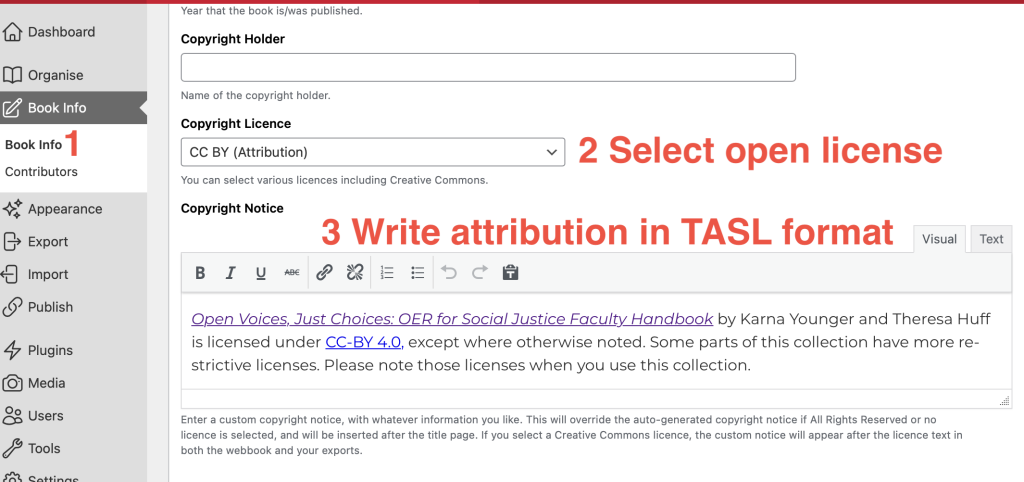Blossoming and Sharing: Publishing Your OER
Licensing Statement
Karna Younger
Why include a licensing statement?
Up to this point we have discussed the importance of TASL statements for elements of your OER, but a licensing statement for your whole OER should be included in the Book Info of your Pressbooks and within your front matter.
Step 1: Add license to your book information
Show/Hide
To make certain your license displays on the landing page and footer of your Pressbook, you will need to update the licensing information in your book information, located under “Book Info” of your main tool navigation to the left of the screen and at the bottom of the Book Info page. Below is a visual walk-through of the process.

Book Info Page
- Open Book Info page and scroll to Copyright section near the bottom of the page
- Use the drop down box to select your Copyright License, which should be the appropriate Creative Commons license excluding any variation of a No Derivatives license.
- In the Copyright Notice text book, write the TASL attribution for your OER. We also like to include a notation that clarifies the license applies to the collection and that items within the collection may have more restrictive licensing (i.e., including at least “except where otherwise noted” after TASL).
- Ex., Open Voices, Just Choices: OER for Social Justice Faculty Handbook by Karna Younger and Theresa Huff is licensed under CC-BY 4.0, except where otherwise noted. Some parts of this collection have more restrictive licenses. Please note those licenses when you use this collection.
Step 2: Add license statement to your front matter
Show/Hide
When adding a licensing statement to your front matter, there isn’t a set place for you to place it. Here are two options:
- Place your licensing statement on a page titled “About this OER” with additional boilerplate language about different elements of their OER.
- Place your licensing statement on its own page to provide detailed information about your OER licensing. Here, you may collate all licensing details of your remixing process, including the attribution of the original OER source, modifications you have made, and the new license. Some authors elect to even include the licensing information of additional chapter elements, such as images and figures. For example:
- “Source OER Attributions” page in Abnormal Psychology by Jordan A. Cummings.
- “License Attributions” page in Open Voices, Just Choices
NOTE: Many of you have created change logs or are otherwise tracking the modifications you have made to remixed OER. Sharing your change log can be a great transparency tool. We would recommend distinguishing the change log from your attribution statement page, though, and share the change log in the back matter of your OER.
-
- For example, see the Versioning History page in BCCampus’s Accessibility Toolkit, Second Edition by Amanda Coolidge, Sue Doner, Tara Robertson, and Josie Gray.
Don’t Forget
- Licensing or attribution statements should be throughout your OER. Locations may include in captions for images and figures, in the metadata of your images, figures, and H5P, in footnotes, and at the bottom of chapter pages.
- For a variety of attribution examples and guidance, see “Attribution Style Guide” by Michaela Willi Hooper for Open Oregon Educational Resources.
Resources
Abnormal Psychology by Jordan A. Cummings is licensed under CC BY-NC-SA 4.0.
Accessibility Toolkit, Second Edition by Amanda Coolidge, Sue Doner, Tara Robertson, and Josie Gray is licensed under CC BY 4.0.
“Attribution Style Guide” by Michaela Willi Hooper for Open Oregon Educational Resources is
licensed under CC BY 4.0.
Attribution
“Licensing Statement” by Karna Younger is licensed under CC BY 4.0.
